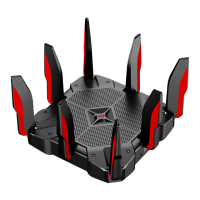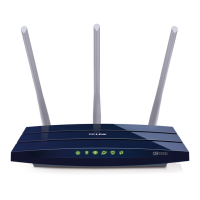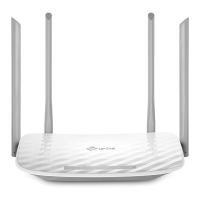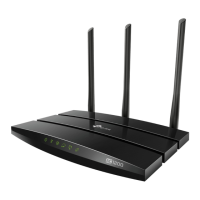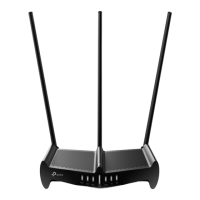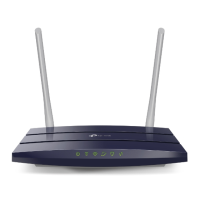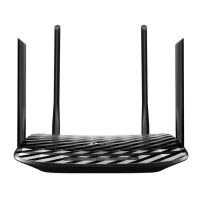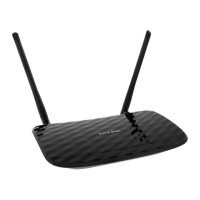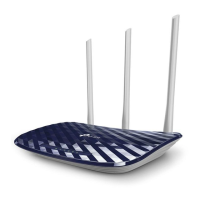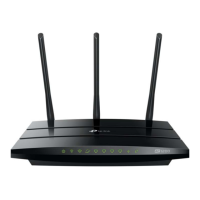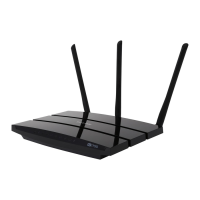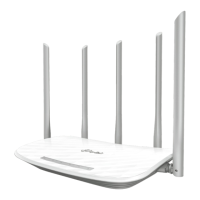Do you have a question about the TP-Link Archer C5400 and is the answer not in the manual?
Explains symbols and formatting used in the guide.
Introduces the router's capabilities and features.
Lists the key functionalities and specifications of the router.
Details the physical layout and indicators on the router.
Explains the function of each button on the router's front panel.
Details the ports and connectors on the rear panel of the router.
Provides guidance on optimal placement for the router.
Step-by-step instructions for physically connecting the router.
Explains how to connect a computer to the router wirelessly or via Ethernet.
Guides users through the automated internet setup process.
Details the steps for configuring an IPv6 internet connection.
Explains how to manually set up internet connection parameters.
Steps to set up a separate Wi-Fi network for guests.
Options to control guest network access and permissions.
Instructions for sharing USB storage devices on the network.
How to configure specific folder sharing and access permissions.
How to access USB storage remotely using FTP.
Enables sharing media files from USB storage via DLNA.
Allows sharing a USB printer connected to the router.
How to share a 3G/4G modem connection.
Step-by-step guide to setting up parental controls and website restrictions.
How to configure QoS rules to prioritize network traffic.
Instructions for updating the QoS database for application support.
Guides on using SPI Firewall and DoS Protection for network defense.
How to block or allow specific devices on the network.
Steps to bind IP and MAC addresses to prevent ARP attacks.
How to host services like websites or FTP servers.
Dynamically opens ports for applications like games or VoIP.
Configures a PC as a DMZ host for unrestricted access.
Enables UPnP for seamless online gaming and communication.
Guides on setting up an OpenVPN server for remote access.
Instructions for setting up a PPTP VPN server for remote access.
How to modify the router's LAN IP address and subnet.
Steps to set up IPTV service using IGMP or other modes.
Configuration options for the DHCP server and IP address reservation.
How to configure DDNS for remote access using a domain name.
Manually configure routing rules for specific network paths.
Customize wireless network name (SSID), password, and security.
How to use WPS for easy Wi-Fi device connection.
Set schedules for automatically turning wireless radios on/off.
How to configure the router's system time for accurate logging and features.
Tools for diagnosing network connection issues.
Steps to update the router's firmware for new features and security.
Save and load router settings for backup or recovery.
How to change the router's login username and password.
Set up email notifications for password recovery.
Limit router management access by MAC address.
Configure settings for managing the router remotely.
View system logs for troubleshooting and monitoring.
Track network traffic volume and packet data.
Turn router LEDs on or off, including night mode settings.
Steps to recover forgotten wireless network passwords.
Procedures to retrieve admin login credentials if lost.
Troubleshooting steps for login issues with the router's interface.
Details RF exposure limits and compliance requirements.
Explains symbols and formatting used in the guide.
Introduces the router's capabilities and features.
Lists the key functionalities and specifications of the router.
Details the physical layout and indicators on the router.
Explains the function of each button on the router's front panel.
Details the ports and connectors on the rear panel of the router.
Provides guidance on optimal placement for the router.
Step-by-step instructions for physically connecting the router.
Explains how to connect a computer to the router wirelessly or via Ethernet.
Guides users through the automated internet setup process.
Details the steps for configuring an IPv6 internet connection.
Explains how to manually set up internet connection parameters.
Steps to set up a separate Wi-Fi network for guests.
Options to control guest network access and permissions.
Instructions for sharing USB storage devices on the network.
How to configure specific folder sharing and access permissions.
How to access USB storage remotely using FTP.
Enables sharing media files from USB storage via DLNA.
Allows sharing a USB printer connected to the router.
How to share a 3G/4G modem connection.
Step-by-step guide to setting up parental controls and website restrictions.
How to configure QoS rules to prioritize network traffic.
Instructions for updating the QoS database for application support.
Guides on using SPI Firewall and DoS Protection for network defense.
How to block or allow specific devices on the network.
Steps to bind IP and MAC addresses to prevent ARP attacks.
How to host services like websites or FTP servers.
Dynamically opens ports for applications like games or VoIP.
Configures a PC as a DMZ host for unrestricted access.
Enables UPnP for seamless online gaming and communication.
Guides on setting up an OpenVPN server for remote access.
Instructions for setting up a PPTP VPN server for remote access.
How to modify the router's LAN IP address and subnet.
Steps to set up IPTV service using IGMP or other modes.
Configuration options for the DHCP server and IP address reservation.
How to configure DDNS for remote access using a domain name.
Manually configure routing rules for specific network paths.
Customize wireless network name (SSID), password, and security.
How to use WPS for easy Wi-Fi device connection.
Set schedules for automatically turning wireless radios on/off.
How to configure the router's system time for accurate logging and features.
Tools for diagnosing network connection issues.
Steps to update the router's firmware for new features and security.
Save and load router settings for backup or recovery.
How to change the router's login username and password.
Set up email notifications for password recovery.
Limit router management access by MAC address.
Configure settings for managing the router remotely.
View system logs for troubleshooting and monitoring.
Track network traffic volume and packet data.
Turn router LEDs on or off, including night mode settings.
Steps to recover forgotten wireless network passwords.
Procedures to retrieve admin login credentials if lost.
Troubleshooting steps for login issues with the router's interface.
Details RF exposure limits and compliance requirements.
| DSL WAN | No |
|---|---|
| Ethernet WAN | Yes |
| Wi-Fi band | Tri-band (2.4 GHz / 5 GHz / 5 GHz) |
| Wi-Fi standards | 802.11a, Wi-Fi 5 (802.11ac), 802.11b, 802.11g, Wi-Fi 4 (802.11n) |
| Top Wi-Fi standard | Wi-Fi 5 (802.11ac) |
| WLAN data transfer rate (max) | 2167 Mbit/s |
| Number of WLAN connections (max) | 5 |
| WLAN data transfer rate (third band) | 1000 Mbit/s |
| VPN support | PPTP, L2TP, IPSec |
| Cabling technology | 10/100/1000Base-T(X) |
| Networking standards | IEEE 802.11a, IEEE 802.11ac, IEEE 802.11b, IEEE 802.11g, IEEE 802.11n |
| Ethernet LAN data rates | 10, 100, 1000 Mbit/s |
| Ethernet LAN interface type | Gigabit Ethernet |
| Memory card slot(s) | - |
| USB 3.2 Gen 1 (3.1 Gen 1) Type-A ports quantity | 1 |
| Security algorithms | 64-bit WEP, 128-bit WEP, WPA, WPA-PSK, WPA2, WPA2-PSK |
| Antennas quantity | 8 |
| Product type | Tabletop router |
| Product color | Black |
| LED indicators | Power |
| Processor cores | 2 |
| Processor frequency | 1.4 MHz |
| Windows operating systems supported | Windows 10 Education, Windows 10 Education x64, Windows 10 Enterprise, Windows 10 Enterprise x64, Windows 10 Home, Windows 10 Home x64, Windows 10 Pro, Windows 10 Pro x64, Windows 7 Enterprise, Windows 7 Enterprise x64, Windows 7 Home Basic, Windows 7 Home Basic x64, Windows 7 Home Premium, Windows 7 Home Premium x64, Windows 7 Professional, Windows 7 Professional x64, Windows 7 Starter, Windows 7 Starter x64, Windows 7 Ultimate, Windows 7 Ultimate x64, Windows 8, Windows 8 Enterprise, Windows 8 Enterprise x64, Windows 8 Pro, Windows 8 Pro x64, Windows 8 x64, Windows 8.1, Windows 8.1 Enterprise, Windows 8.1 Enterprise x64, Windows 8.1 Pro, Windows 8.1 Pro x64, Windows 8.1 x64, Windows Vista Business, Windows Vista Business x64, Windows Vista Enterprise, Windows Vista Enterprise x64, Windows Vista Home Basic, Windows Vista Home Basic x64, Windows Vista Home Premium, Windows Vista Home Premium x64, Windows Vista Ultimate, Windows Vista Ultimate x64, Windows XP Home, Windows XP Home x64, Windows XP Professional, Windows XP Professional x64 |
| Output current | 5 A |
| Output voltage | 12 V |
| Power source type | DC |
| Storage temperature (T-T) | -40 - 70 °C |
| Operating temperature (T-T) | 0 - 40 °C |
| Storage relative humidity (H-H) | 5 - 90 % |
| Operating relative humidity (H-H) | 10 - 90 % |
| Cables included | LAN (RJ-45) |
| Package type | Box |
| Width | 230 mm |
|---|---|
| Height | 43 mm |
